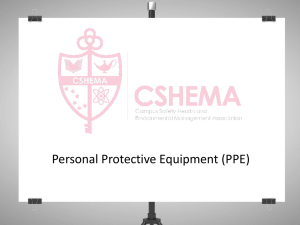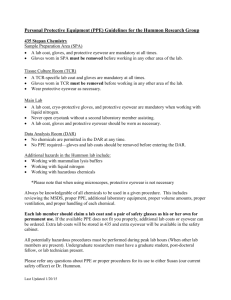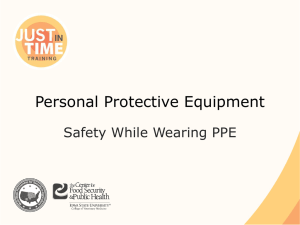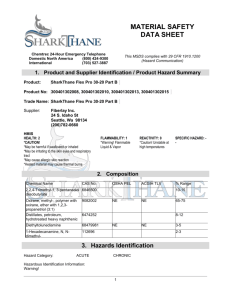Section 5 - Western Washington University
advertisement
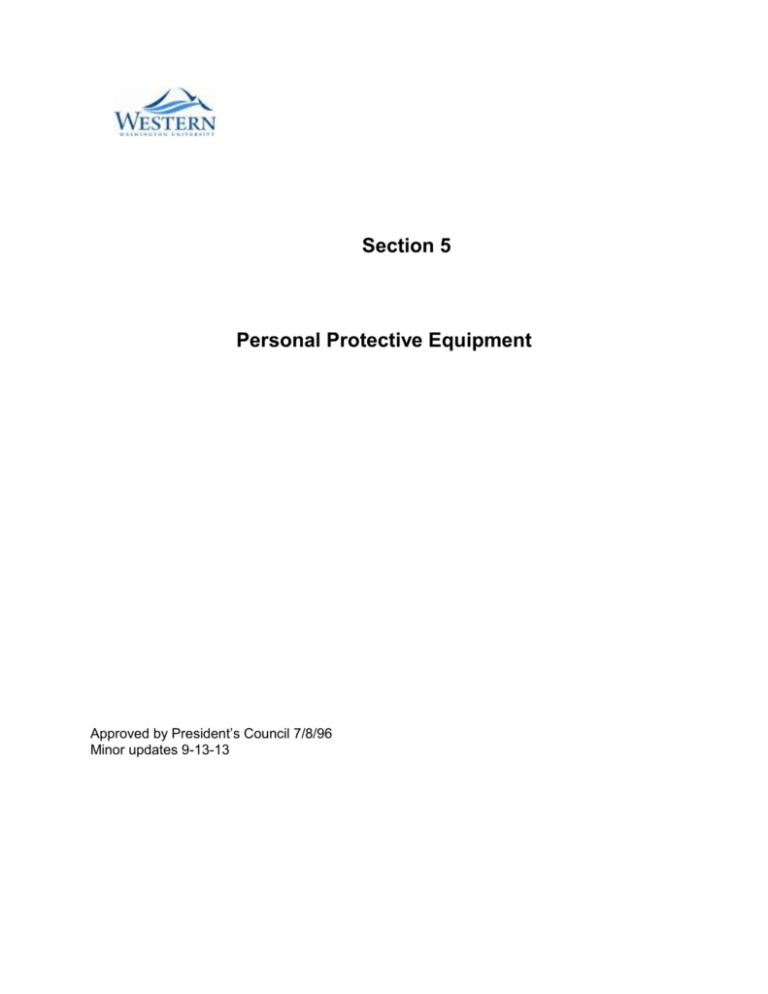
Section 5 Personal Protective Equipment Approved by President’s Council 7/8/96 Minor updates 9-13-13 Back of Title Page Safety Information Book Personal Protective Equipment Personal Protective Equipment A. Introduction Washington State Department of Labor and Industries standard WAC 296-24-0751 requires the use of personal protective equipment to protect the body from absorption, inhalation and physical contact hazards having the potential to cause injury or impairment. This standard mandates that WWU conduct certified assessments of all workplaces to determine if hazards are present, or likely to be present, which necessitate the use of personal protective equipment (PPE). Personal protective equipment is provided by the organizational unit in accordance with union contracts and other University agreements. It is used when workplace hazards are not eliminated or controlled by engineering controls (i.e., guards, ventilation) and/or administrative controls (i.e., job rotation, work practices). Faculty, staff, exempt professionals and student employees required to wear PPE must be trained in its proper use and limitations. Students should also receive training. Environmental Health and Safety (EHS) has developed these materials to assist departments or organizational units in conducting hazard assessments and training to achieve regulatory compliance and enhance employee protection. Training support in PPE is obtained by contacting EHS. B. Hazard Assessment To assess areas and work practices that potentially necessitate the use of PPE, a walk-through survey should be conducted. The purpose of the walk-through survey is to identify hazards and their sources that faculty, staff, exempt professionals and student employees are potentially exposed to during the course of their work. Although not required by regulation, students’ exposures should likewise be documented. The walk-through survey is to be performed by supervisory personnel such as department heads, chairs, directors, faculty members in charge of shops or laboratories, or supervisors who are responsible for the working conditions and practices in their areas. Hazard assessments are conducted by observing work practices and obtaining information from potentially exposed persons. Identified hazards are to be eliminated or controlled using engineering and administrative controls when technologically and economically feasible. However, when engineering and administrative controls are not feasible or do not completely eliminate the hazard, PPE must be used. General hazard categories (not all inclusive) requiring assessment of head, eye, face, hand, foot, and respiratory hazards that exist in an occupational or educational setting are as follows: IMPACT /PENETRATION COMPRESSION (ROLLOVER) HEAT LIGHT (OPTICAL) RADIATION NOISE CHEMICAL CONTACT RESPIRABLE HAZARDS ELECTRICAL SHOCK During the walk-through survey the following hazard sources should be evaluated: SOURCES OF MOTION (i.e., machinery or processes where any movement of tools, machine components or particles could exist) SOURCES OF HIGH TEMPERATURES (resulting in burns, eye injury or ignition of clothing) CHEMICAL EXPOSURES TO EYES AND SKIN SOURCES OF DUSTS, FUMES, MISTS, AND VAPORS SOURCES OF LIGHT RADIATION (i.e., welding, brazing, cutting, furnaces, lasers) SHARP AND/OR ROLLING OBJECTS SOURCES OF FALLING OBJECTS (or potential for dropping objects) ELECTRICAL EQUIPMENT 5-1 Safety Information Book Personal Protective Equipment The Personal Protective Equipment Selection Charts (Appendix A to this section) have been developed to assist supervisory personnel in assessing their work areas and selecting the appropriate PPE. Though all work places are required to be assessed, hazards requiring the use of PPE will generally not be found in office type work areas. Contact WWU’s Office of Environmental Health and Safety to conduct noise and respiratory hazard assessments where applicable. A hazard re-assessment must be conducted whenever new equipment or processes are introduced or the review of occupational injury and illness records by the organizational unit or safety professional indicate the need for PPE. C. Hazard Assessment Certification WAC 296-24-07501 specifies that WWU shall verify that the hazard assessment has been performed through a written certification. After surveying work areas and practices, the supervisor completes the Workplace Hazard Assessment Certification form (Appendix A to this section). An example of a completed form is also in Appendix A. If a work area assessment does not reveal hazards requiring the use of PPE, mark the No PPE Required box on the upper left of the Workplace Hazard Assessment Certification form. This form must be retained by the department and a copy forwarded to EHS (Mail Stop 9070). The purpose of this assessment is to document mandatory personal protective equipment. If, during the hazard assessment, tasks are indicated for which protective equipment is optional, these may be listed as such on the form. D. Personal Protective Equipment Selection Upon completing the hazard assessment, each unit selects and provides the types of PPE suitable for the specific hazards present. Careful consideration must be given to the level of protection, fit and comfort of the PPE. Personal protective equipment that fits poorly will not afford the necessary level of protection. Protective devices are generally available in a variety of sizes and care should be taken to ensure that the right size is selected. Some PPE is equipped with adjustable features. Adjustments should be made on an individual basis for a comfortable fit that will maintain the protective device in the proper position. However, PPE should never be modified without written approval from the manufacturer. E. Training Faculty, staff, exempt professionals, and student employees must receive information and training on how to use the assigned PPE. Students should be trained as well. Personal protective equipment must always be used in accordance with the manufacturer’s specifications. Training is provided by the Environmental Health and Safety office; however, organizational units may provide their own training at their discretion. Training and information to be provided to each user of PPE includes: Why, when, and what PPE is necessary How to properly don, doff, adjust, and wear PPE The selection criteria and limitations of the PPE The proper care, inspection, maintenance, useful life and disposal of the PPE Manufacturer’s literature, the supplying vendor, and EHS are sources for PPE selection and training assistance and materials. Employees using respirators and hearing protection are to be trained by Environmental Health and Safety personnel. The Audiology Clinic may also provide hearing protection training. 5-2 Safety Information Book Personal Protective Equipment Each employee must demonstrate an understanding of this training before being allowed to perform work requiring the use of PPE. Methods of demonstrating understanding include orally questioning the employee, observing the employee using the PPE in a real or artificial setting, or administering a written test. Employees who wear personal protective equipment which is optional are to be trained in how to don, doff, adjust and wear PPE and the proper care, inspection, maintenance, use and disposal. Limitations of the PPE should also be addressed. Employees must be retrained when there have been: 1. Changes in the workplace, such as new processes and equipment, which render previous training obsolete. 2. Changes in the types of PPE which render the previous training obsolete. 3. Inadequacies in an employee’s knowledge or use of assigned PPE which indicate that the employee has not retained the requisite understanding or skill. F. Training Certification A written certification must be completed by the trainer verifying that each employee using PPE has received and understood the required training. After faculty, staff, exempt professionals or student employees have received training, the supervisor completes the Personal Protective Equipment Training Certification form in Appendix A to this section. A copy is returned to EHS at Mail Stop 9070. G. Special Equipment and Assistance The personal protective equipment selection charts in Appendix A to this section only address the most frequently encountered hazards and recommended PPE. Therefore, the contents are not all inclusive. Hazards not listed may be found in your work area and special PPE could be needed. If you require assistance in the following areas, contact Environmental Health and Safety at 650-3064. Conducting a hazard assessment Selecting PPE Determining whether American National Standards Institute (ANSI) standards are appropriate to your needs Conducting training Respirator or hearing information 5-3 Safety Information Book Personal Protective Equipment This page left blank 5-4 Safety Information Book Personal Protective Equipment Appendix A to Section 5 Personal Protective Equipment Supplemental Information and Forms Contents: 1. 2. 3. 4. Personal Protective Equipment Selection Charts Workplace Hazard Assessment Certification Form Example of Completed Workplace Hazard Assessment Certification Training Certification Form A5-1 Safety Information Book Personal Protective Equipment Personal Protective Equipment Selection Charts Eye And Face Protection Eye and face protective equipment should be routinely considered for occupations such as, but not limited to, carpenters, electricians, machinists, mechanics, plumbers and pipefitters, lathe and milling machine operators, welders, grounds-keepers, and employees using chemicals. General eye and face protective equipment selection criteria: All eye and face protective equipment shall comply with ANSI Z87.1989, except eye protection designed for laser operations. Laser protective eyewear optical density is dependent on laser wavelength (Contact EHS or Radiation Safety for further information). Care should be taken to recognize the possibility of multiple and simultaneous exposure to a variety of hazards. Adequate protection against the highest level of each of the hazards should be required. As a general rule, if they are required, face-shields are worn over primary eye protection (spectacles or goggles). Wearers of contact lenses must also wear appropriate eye and face protection devices in a hazardous environment. Dusty and/or chemical environments may represent an additional hazard to contact lens wearers. Operations involving heat may also produce light radiation. Protection from both hazards is required. Protection from light radiation is directly related to spectacle filter density. Select the darkest shade that allows task performance. Caution should be exercised in the use of metal frame protective devices in electrical hazard area. Eye And Face Protection Selection Chart SOURCE/ACTIVITY HAZARD PROTECTION IMPACT: Grinding, machining, masonry work, woodworking, sawing, drilling, powered fastening, riveting and sanding. Flying fragments, objects, chips and sand particles. Spectacles with side protection, goggles, and face shields. HEAT: Welding, furnace operations, pouring and casting. Hot sparks. Goggles, spectacles with side protection. For severe exposure use face-shields. Splash from molten metals. Face-shields worn over goggles. High temperature exposure. Screen face-shields, reflective face-shields. DUST: Woodworking, buffing, and grain and coal handling. Dust. Goggles. A5-2 Safety Information Book Personal Protective Equipment Eye And Face Protection Selection Chart - Continued SOURCE/ACTIVITY HAZARD PROTECTION LIGHT and/or RADIATION: Welding - Electric Arc Optical Radiation Welding helmets or shields. Typical shades: 10-14. Welding - Gas Optical Radiation Welding goggles or faceshields. Typical shades: gas welding 4-8, cutting 3-6, brazing 3-4. Cutting, Torch Brazing, Torch Soldering Optical Radiation Lasers Thermal exposure, acoustic, photochemical CHEMICALS: Laboratory research, chemical handling and transferring, custodial, construction and maintenance operations. Spectacles or welding faceshield. Typical shades: 1.5-3. Protective eyewear with an optical density for the specific application. Refer to the laser manufacturer’s operations manual or ANSI Z136.1 (1993). Splash Goggles, eyecups, faceshields. See Material Safety Data Sheet for appropriate eye and face protection. Vapor and Gas Exposures Goggles must be nonventilated. See Material Safety Data Sheet for appropriate eye and face protection. Foot Protection Foot protective equipment should be routinely considered for occupations such as, but not limited to, carpenters, electricians, machinists, mechanics, plumbers and pipefitters, dry wallers, welders, grounds-keepers, shipping and receiving clerks, warehouse workers, and employees using chemicals. Foot Protection Selection Chart SOURCE/ACTIVITY HAZARD PROTECTION IMPACT: Carrying or handling materials such as packages, parts, or heavy tools. Falling objects. Safety shoes or boots complying with ANSI Z41-1991 or equally effective alternative. COMPRESSION: Manual and powered material handling equipment, bulk rolls and heavy tools. Rolling or pinching equipment and objects. Safety shoes or boots complying with ANSI Z41-1991 or equally effective alternative. A5-3 Safety Information Book Personal Protective Equipment Foot Protection Selection Chart SOURCE/ACTIVITY PUNCTURE: Construction and demolition activities. ELECTRICAL: Construction and maintenance of electrical service. HEAT. Foundry work, cutting/welding CHEMICAL: Laboratory research, chemical handling and transferring, custodial, construction and maintenance operations. HAZARD PROTECTION Stepping on nails, tacks, screw, large staples or scrap metal. Electrical shock and electrocution. Safety shoes or boots with puncture resistant soles. Thermal burns Substantial footwear Splash - skin burns and absorption toxicity. Impervious rubber boot or bootie covering the shoe. Pant leg or lab coat should pass over top of boot/shoe to prevent chemical from entering footwear. Electrical insulating safety shoes. Head Protection Head protective equipment should be routinely considered for occupations such as, but not limited to, carpenters, electricians, machinists, mechanics, plumbers and pipefitters, dry wallers, welders, grounds-keepers, shipping and receiving clerks and warehouse workers. Head protective equipment selection criteria: Protective helmets shall comply with ANSI Z89.1-1986. Proper fitting of a helmet is important to ensure it will not fall off. In some cases a chin strap may be necessary. Head Protection Selection Chart SOURCE/ACTIVITY HAZARD PROTECTION IMPACT/PENETRATION: Construction, repair, demolition and tree trimming. Overhead hazards, falling objects. Type A, B, C Protective Helmets. ELECTRICAL: Electrical utility installation and repair. Electrical shock and electrocution. Class A Protective Helmets (Impact/penetration protection and proof tested to 2,200 volts). Class B Protective Helmets (Impact/penetration, protection, and proof tested to 20,000 volts). HEAT. Foundry and welding/cutting ENTANGLEMENT: Rotating machinery. Thermal burns Hair becoming entangled in moving parts. A5-4 Protective helmets, caps, or covering Caps or other protective hair coverings. Safety Information Book Personal Protective Equipment Hand Protection Gloves are often relied upon to prevent cuts, abrasions, burns and skin contact with chemicals that are capable of causing local or systemic effects following dermal exposure. There is not a single glove that provides protection against all potential hand hazards; therefore, it is important to select the most appropriate glove for a particular application and to determine how often and long it can be worn and whether it can be reused. Physical and chemical hand protective equipment selection criteria: Work activities should be evaluated to determine the degree of dexterity required, the duration, frequency, type of exposure, degree of exposure, and the physical stresses that will be applied. The type and toxic properties of the chemical(s) must be determined; in particular, the ability of the chemical to cause local effects on the skin and/or to pass through the skin and cause systemic effects. For mixtures and formulated products (unless specific test data are available), a glove should be selected on the basis of the chemical component with the shortest breakthrough time. Electrical hand protective equipment selection criteria and testing: Rubber insulating gloves should meet the American Society for Testing and Materials (ASTM D 120-87), Specification for Rubber Insulating Gloves. Electrical protective equipment, including gloves, shall be subject to periodic electrical tests. Rubber gloves are to be tested before first use and every 6 months thereafter. Hand Protection Selection Chart SOURCE/ACTIVITY HAZARD PROTECTION SHARP TOOLS/MATERIALS: Cutting, dissecting, dicing, butchering, handling sharp or ragged objects. Lacerations from blades, knives, glass, sheet metal. Splinters from rough lumber. Abrasions. Leather, wire mesh or stitch gloves, cut-resistant rubber gloves. THERMAL HEAT: Cooking, welding, soldering, brazing, foundry work, steam line/furnace repair, autoclaves. Thermal Heat. Leather gloves, flame retarding gauntlet gloves, chemical treated cloth gloves. EXTREME COLD: Handling cold materials, cryogenic research. Frostbite. Permeable or impervious noninsulated gloves, permeable or impervious insulated gloves. ELECTRICAL: Electrical utility installation and repair. Electrical shock and electrocution. Rubber insulated voltage rated gloves, other gloves rated for electrical work. CHEMICAL: Laboratory research, chemical handling and transferring, custodial, construction and maintenance operations. Glove permeation and degradation causing dry skin, dermatitis, burns, irritation or ulceration Gloves composed of chemically compatible material. Refer to the Material Safety Data Sheet. Contact EHS for assistance. A5-5 Safety Information Book Personal Protective Equipment Hearing Protection Hearing protective equipment should be routinely considered for occupations such as, but not limited to, carpenters, plumbers, welders, grounds-keepers, printing press operators, musicians and heavy equipment operators. Employees exposed to noise at 85 dBA and higher based on an 8 hour time weighted average are to be included in WWU’s hearing conservation program. The program includes noise monitoring, the use of appropriate hearing protection, annual audiometric testing, and annual training. Contact Environmental Heath and Safety to arrange a noise hazard assessment. Hearing Protection Selection Chart SOURCE/ACTIVITY HAZARD NOISY EQUIPMENT AND PROCESSES: High speed tools, heavy mobile equipment and frequent use of mechanized equipment. Noise induced hearing loss. PROTECTION Ear plugs, ear muffs with the appropriate Noise Reduction Rating (NRR). Respiratory Protection Respiratory protective equipment should be routinely considered for occupations such as, but not limited to, painters, asbestos abatement workers, pesticide applicators, laboratory researchers and hazardous waste technicians. Respiratory protective equipment should also be considered for employees and students engaged in activities such as construction, demolition, welding and sanding which create dusts and fumes. Employees required to wear respirators are to be included in a written respiratory protection program. The program includes air monitoring, fit testing, the use of appropriate respiratory protective equipment and annual training. Employees potentially exposed to specific contaminants (e.g., lead, asbestos) are to be covered by a medical surveillance program. Contact Environmental Heath and Safety to arrange a respiratory hazard assessment. Respiratory Protective Selection Chart SOURCE/ACTIVITY Employees exposed to activities creating dusts, mist, fumes and vapors. HAZARD Oxygen deficient atmospheres, irritants, carcinogens, sensitizers and other health effects. PROTECTION Supplied air respirators (SCBAs, air-line) and airpurifying respirators (half and full face). Miscellaneous Personal Protective Equipment Personal protective equipment not listed on the preceding charts may be required when employees are exposed to laceration, burn, abrasion, chemical and fall hazards. Personal protective equipment to consider includes: chaps, aprons, lab coats, protective sleeves, knee pads, coveralls, safety vests, welding coats, and personal fall restraint and arrest systems. Gloves and CPR shields are also provided as apart of first aid kits. Contact Environmental Health and Safety at 650- 3064 for further assistance. A5-6 Workplace Hazard Assessment Certification Instructions: Complete table, retain one copy for departmental records and forward one copy to Environmental Health and Safety MS-9070. Department: Hazard Assessment Certified By: Personal Protective Equipment Not Required Date of Hazard Assessmen t Person Conducting Assessmen t Phone Number Location of Assessment (Bldg/Rm) Work Activity Assessed A5-7 Date: Hazard Identified PPE Selected (Manufacturer/Model Number) Workplace Hazard Assessment Certification - Example Instructions: Complete table, retain one copy for departmental records and forward one copy to Environmental Health and Safety MS-9070. Department: Business/Academic Department Hazard Assessment Certified By: Personal Protective Equipment Not Required Location of Assessment (Bldg/Rm) Work Activity Assessed Date: 01-01-01 Hazard Identified PPE Selected (Manufacturer/Model Number) Date of Hazard Assessmen t 01-01-01 Person Conducting Assessmen t G. Stone XXXX Plumbing Grinding - Metal Flying Particles 01-01-01 G. Stone XXXX ET/106 Grinding - Metal Noise Safety glasses with side shields or goggles Ear plugs or muffs 01-01-01 G. Stone XXXX ET Gas Welding 01-01-01 G. Stone XXXX Plumbing Gas Welding Flash burn (optical radiation) Burns to hands Welding goggles with 4-8 shading Leather gloves 01-01-01 C. Stump XXXX Grounds Tree Trimming Falling branches Hard hats - Type C 01-01-01 C. Stump XXXX Grounds Tree Trimming Noise Ear plugs or muffs * 01-01-01 C. Stump XXXX Grounds Tree Trimming Abrasion to hands Gloves 01-01-01 B. Sharp XXXX Wire mesh gloves S. Blades XXXX S. Blades XXXX 01-01-01 S. Hand XXXX Formaldehyde - respiratory exposure Formaldehyde - skin exposure No hazard Air purifying respirators * 01-01-01 Cutting meats and vegetables Preserved tissue preparation Preserved tissue preparation Office Work Cuts to hands 01-01-01 VU EateriesFood Prep Biology BI363 Biology BI363 EHS PS111 * Phone Number Person’s Name Contact Environmental Health and Safety at 650-3064 to arrange a hazard assessment. A5-8 Polyethylene gloves Not Applicable Certification for Personal Protective Equipment Training Instructions: Train each employee required to use personal protective equipment (PPE) in the following: When PPE is necessary What PPE is necessary How to properly don, doff, adjust, and wear PPE Limitations of PPE Care, maintenance, useful life, and disposal of PPE The person providing training verifies that each employee has received and understood the required training by signing below: Name of Training Provider (print): __________________________________________________ Signature of Training Provider: _____________________________________________________ Date(s) of Training: __________________ Department MS: _________________ Department: _______________________________ Department Phone: _____________________________ Check the types of personal protective equipment* for which training has been provided: * Respiratory protection training is provided by Environmental Health and Safety or through the asbestos program. Hearing equipment training is provided by Environmental Health and Safety or the Audiology Clinic. List Names of Employee(s) Trained Below A5-9


